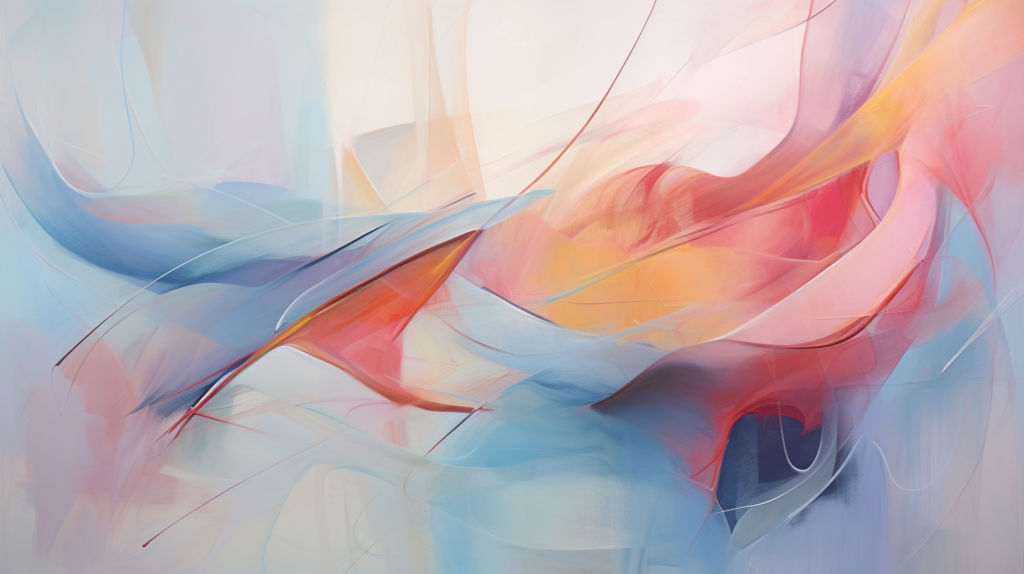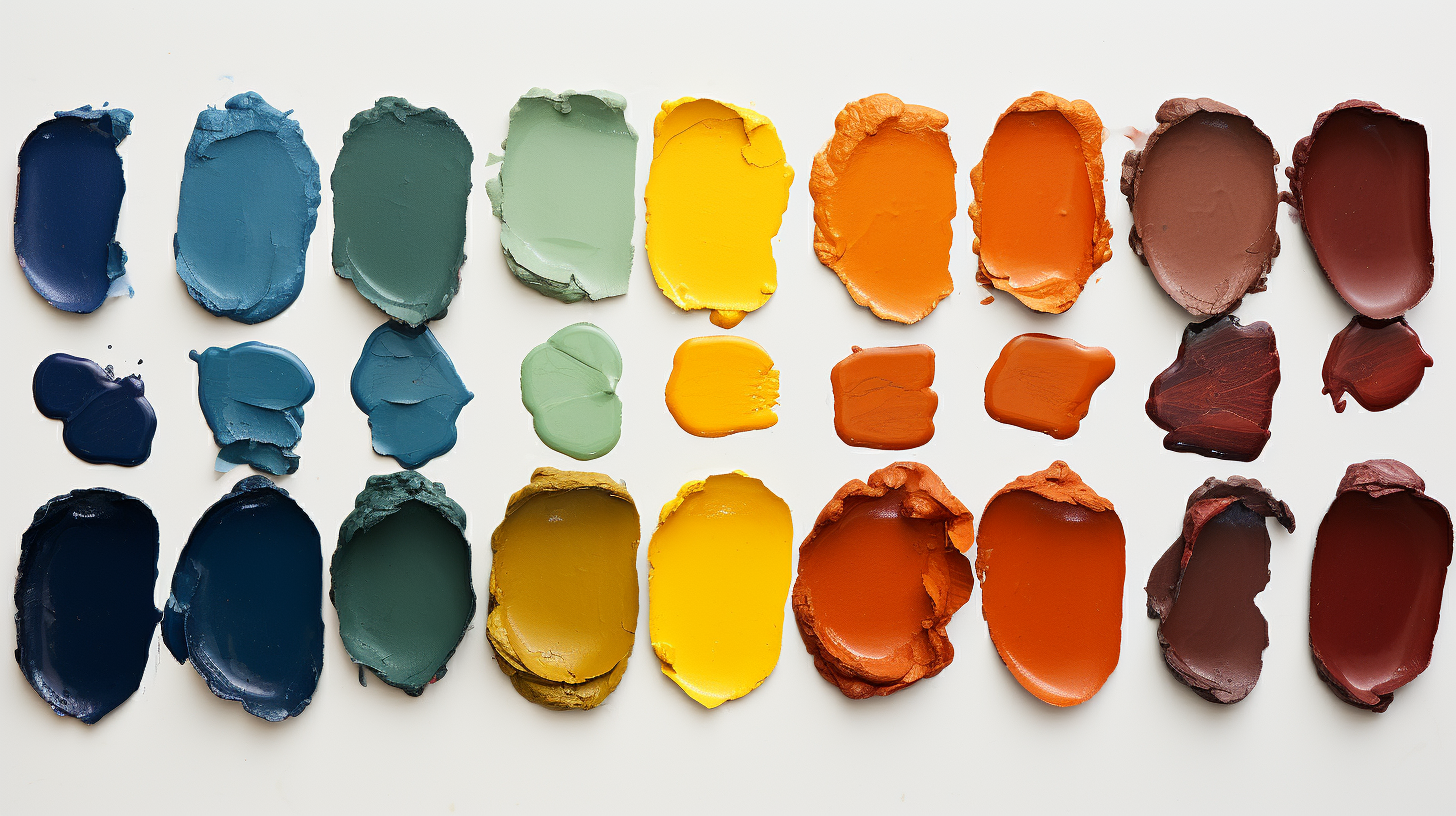Acrylic paints are one of the most versatile mediums used by artists worldwide. From heavy body acrylic paint to soft body to fluid acrylics, these paints offer unique characteristics that influence artists’ techniques and result in stunning artwork. Understanding the differences between these types of acrylic paints can help enhance your creativity and achieve better artistic results.
In this article, we will explore the main differences between heavy body, soft body, and fluid acrylic paints. We will delve into their individual properties, advantages, and techniques, providing insights on how to choose the right type of acrylic paint for your artistic style and preferred applications.
Key Takeaways:
- There are three main types of acrylic paints: heavy body, soft body, and fluid acrylics.
- Heavy body acrylic paints have a thick consistency and retain brush strokes, making them ideal for texture-based artwork.
- Soft body acrylics have a thinner consistency and are perfect for techniques like glazing, pouring, and airbrushing.
- Fluid acrylics have a highly liquid consistency and are excellent for pour-based artwork and staining techniques.
- Choosing the right type of acrylic paint depends on the artist’s preferred style, texture, and application techniques.
What is Heavy Body Acrylic Paint?
Heavy body acrylic paint is a type of acrylic paint that has a thick, buttery consistency. It is known for its ability to retain brush strokes, making it a popular choice for artists who want to create textured effects in their paintings.
Unlike soft body and fluid acrylic paints, which have a more liquid consistency, heavy body acrylic paints are ideal for use with a knife or a brush, allowing artists to build up layers and create depth in their paintings.
One of the main advantages of heavy body acrylic paints is their high pigment load, which means that they have a greater color intensity than other types of acrylic paints. They are also highly opaque, making them perfect for use on darker surfaces or for covering up mistakes.
Some popular brands of heavy body acrylic paint include Golden Heavy Body Acrylics, Liquitex Heavy Body Acrylics, and Winsor & Newton Professional Acrylics.
Exploring Soft Body Acrylic Paint
Soft body acrylic paint is a type of acrylic paint that has a creamy, smooth consistency. Unlike heavy body acrylic paint, soft body acrylic paint has a lower viscosity, making it flow more freely and allowing for easier blending. On the other hand, soft body acrylic paint is more viscous than fluid acrylic paint, which has a more watery consistency.
Due to its unique properties, soft body acrylic paint is an ideal choice for techniques that require a smooth, fluid application, such as pouring, glazing and illustrating. Its viscosity also makes it great for airbrushing and creating fine details.
Soft body acrylic paint is available in a wide range of colors and brands, including Liquitex, Golden, and Winsor & Newton. Its versatility and ability to create a variety of effects make it a popular choice among artists of all levels.
Understanding Fluid Acrylic Paints
Fluid acrylic paints are unique, versatile, and prized by artists who require them to create a wide array of effects in their artwork. Unlike heavy body and soft body acrylic paints, fluid acrylics are lower in viscosity, making them more liquid in nature. This fluidity contributes to their superior flow and leveling capabilities, allowing artists to create smooth, even washes and gradients, no matter the surface.
One of the unique characteristics of fluid acrylics is their ability to self-level, ensuring that the paint dries evenly without brush marks or textural imperfections. This property makes them ideal for applications such as staining, pouring, and creating abstract art where smooth transitions are desirable.
Another advantage of fluid acrylics is their ability to blend seamlessly with other brands, making them a go-to choice for artists that require color accuracy. By mixing different fluid acrylic colors, artists can easily create new and unique shades and nuances, useful in creating gift-quality artworks.
Techniques and Uses of Fluid Acrylics
Fluid acrylic paints are renowned for their versatility and are frequently utilized for creating unique and highly sought-after artworks. Below are the primary techniques and uses of fluid acrylic paints.
| Technique/Use | Description |
|---|---|
| Pouring | Using a variety of tools to layer and pour acrylic paint onto a chosen surface, creating intricate abstractions of varying patterns, forms and textures. |
| Staining | Using diluted fluid acrylic paints to gently tint surfaces without masking the underlying textures and patterns, creating a translucent look. |
| Creating Fluid Art | By pouring fluid acrylics, and then manipulating the paint with a blow dryer, letting the paint move on its own naturally to create a unique-looking artwork. |
Fluid acrylic paints are also frequently utilized for airbrushing, where they offer superior coverage and create smooth, even coatings. They are also a popular choice for creating mixed media art and collage due to their versatility and compatibility with other mediums like ink, watercolor, and gesso.
Pouring Technique
The pouring technique is a popular application of fluid acrylic paint. It involves mixing fluid acrylic paint with a pouring medium and water to create a smooth and consistent texture that flows easily over the canvas. Artists use this technique to create abstract designs and patterns, blending colors and creating organic shapes that appear to move and flow across the canvas. Here’s how Liquitex paint producer teaches the pouring technique.
Staining Technique
Another popular use of fluid acrylics is the staining technique. This method involves applying diluted fluid acrylics to a surface, allowing them to soak into the material, offering rich, transparent and colorful results. Artists use this technique on materials such as wood, paper and other porous surfaces that easily absorb the fluid acrylic paint. Another good tutorial about staining technique is here.
Creating Fluid Art
Another popular technique utilizing fluid acrylics is the creation of fluid art. Artists pour and mix fluid acrylics of different colors, either onto a canvas, a surface that is subsequently picked up and tilted, or onto a flat surface where the artist can manipulate the paint. Although random in design, the creation of fluid art leads to abstract ideas utilizing color combinations, tilting for movement and incorporating other materials that can add to create a three-dimensional effect. An example of how to create fluid art can be found here.
Fluid acrylic paints offer a wide range of uses and applications for artists looking to add more creativity and uniqueness to their work. Their fluidity and versatility make them a popular choice among both experienced and novice artists. Whether an artist is interested in pouring, staining, or fluid art, fluid acrylics can offer a wealth of creative possibilities.

Uses of Heavy Body Acrylics
Heavy body acrylic paints have become increasingly popular among artists for several reasons. One of the most significant advantages of using heavy body acrylics is their ability to retain brush strokes. This makes them an excellent choice for creating textured and layered artworks that display a certain level of depth and dimensionality.
Additionally, heavy body acrylics are known for their opacity, which is ideal for artists looking to create vibrant and bold paintings. These paints are highly pigmented, allowing them to produce bright, intense colors that attract the viewer’s attention and evoke emotion.
Here are some of the common uses and techniques suitable for heavy body acrylic paints:
Textured Layers
Due to their thick consistency, these paints are excellent for building up textured layers on a canvas. Artists can layer colors for a dynamic, tactile effect.
Blending and Mixing
Heavy body acrylics blend smoothly, allowing for a wide range of color mixing possibilities. This is especially useful for artists who want to create custom colors or gradients.
Impasto Technique
Heavy body acrylics are ideal for impasto, where paint is applied thickly to create texture. The paint retains brush or palette knife marks, giving the artwork a three-dimensional appearance.
Sgraffito Technique
This involves scratching through a top layer of paint to reveal layers underneath. The thickness of heavy body acrylics makes them suitable for this technique, as they provide a substantial layer to work with.
Dry Brush Technique
When applied with a dry brush, heavy body acrylics can create a strong, textured brush stroke effect. This technique is often used for highlighting or adding dimension.
Palette Knife Painting
These paints are great for palette knife painting, allowing for bold, sweeping applications of color and the creation of sharp lines and textures that are harder to achieve with a brush.
Underpainting
Heavy body acrylics can be used for underpainting, providing a solid base layer upon which additional layers of paint can be added.
Mixed Media Art
Their thick texture makes them suitable for mixed media projects. They can be combined with other art materials like pastels, charcoal, or collages for creative effects.
Stenciling and Printing
Their thick consistency is also suitable for stenciling and printing techniques, as they do not bleed under the stencil or screen.
Sculptural Effects
Artists can create sculptural effects on the canvas due to the high viscosity and body of the paint.
Glazing
While typically used for their texture, when thinned with a medium, heavy body acrylics can also be used for glazing techniques, adding depth and luminosity to a painting.
When using heavy body acrylics, it’s important to have the right tools like thicker brushes or palette knives and a sturdy canvas that can hold the weight of the paint. Additionally, experimenting with various mediums can alter the texture and drying time, allowing for even more versatility in their use.
Applications of Soft Body Acrylics
Soft body acrylics are highly versatile and are used in a variety of artwork applications owing to their unique texture and flow. They are an ideal choice for artists who enjoy pouring, glazing, and airbrushing techniques to create fluid and translucent effects.
Painting Applications
Soft body acrylics are perfect for painting applications, as they provide excellent adherence to a variety of surfaces. They can be used as an undercoat to prepare the surface, as a topcoat, or to add fine detail to your artwork. They are also durable and possess excellent lightfastness, which makes them a preferred choice for professional artists.
Pouring Techniques
Soft body acrylics are perfect for pouring techniques. They can add color and texture to surfaces and create unique visual effects. They possess a high flow rate and don’t require much manipulation, which enables even beginners to create intricate artwork.
| Pouring Techniques | Soft Body Acrylics Usage |
|---|---|
| Dirty Pour | Soft body acrylics can be mixed with pouring medium to create stunning dirty pour paintings. |
| Flip Cup | Soft body acrylics can be used to create magnificent Flip Cup paintings as they are runnier, and their high flow rate disperses the colors evenly in the cup. |
| Open Cup | Soft body acrylics produce mesmerizing effects in Open Cup Painting, such as large cells and color transitions. |
Glazing Techniques
Soft body acrylics can create excellent glazing effects when applied in thin layers. This technique is perfect when you want to add depth or change the color balance of your artwork.
Airbrushing
Soft body acrylics are an excellent alternative to traditional airbrush paints. They can be used to achieve the same effects with a mid-level nozzle size. Soft body acrylics are also more affordable than airbrush-specific paints and can be used with any standard airbrush equipment.
Creative applications for the versatile soft body acrylics are virtually limitless. You can experiment with different techniques and surfaces to achieve unique effects and make limitless compositions.
Choosing the Right Acrylic Paint for Your Style
When it comes to choosing the right acrylic paint for your artwork, there are a few factors to keep in mind. One of the most important considerations is your preferred artistic style and technique. Whether you are a painter who enjoys working with impasto techniques or a mixed media artist who likes to create textured surfaces, selecting the right type of acrylic paint can make all the difference in achieving your desired results.
The following table provides a quick summary of the main characteristics of heavy body, soft body, and fluid acrylic paints, and how they may suit your artistic style:
| Acrylic Paint Type | Characteristics | Best for |
|---|---|---|
| Heavy Body | Thick consistency, retains brush strokes, high opacity | Impasto, textured surfaces, bold applications |
| Soft Body | Thin consistency, smooth texture, excellent flow | Pouring, glazing, airbrushing |
| Fluid | Runny consistency, excellent fluidity, excellent transparency | Fluid art, staining techniques, detailed work |
As you can see, each type of acrylic paint offers unique benefits depending on your style and needs. When choosing the right acrylic paint, consider factors such as consistency and texture, desired opacity or transparency, and application methods.
Ultimately, the right acrylic paint for you will depend on your individual preferences and creative goals. By trying out different types and experimenting with various techniques, you’ll be able to discover the best acrylic paint for your unique artistic style.
Exploring Acrylic Paint Brands and Recommendations
There are many great acrylic paint brands on the market, providing artists with a wide range of options to choose from. Here are some popular brands and our recommendations based on quality, affordability, and availability:
| Brand | Type | Recommendation |
|---|---|---|
| Golden | Heavy Body | Top-quality, professional-grade paint with excellent pigmentation and consistency. |
| Liquitex | Soft Body | Quality paint that is ideal for mixing and blending, with a smooth texture and vibrant colors. |
| Winsor & Newton | Fluid | Smooth-flowing paint that is perfect for artists who enjoy pouring or working with thin applications of color. |
| DecoArt | All types | Affordable and accessible brand with a wide variety of colors and finishes, suitable for all levels of artists. |
Ultimately, choosing the right brand and type of paint will depend on your personal preferences and budget. We recommend trying out different brands and types to find the ones that work best for your artistic style and needs.
Conclusion
Understanding the differences between heavy body, soft body, and fluid acrylic paints is essential for any artist who wants to achieve their desired creative results. Each type of paint has unique properties and advantages that can enhance an artist’s technique and style, and choosing the right paint can make all the difference in achieving the desired effect.
Whether an artist is looking for a paint that retains brush strokes, has a specific viscosity, or is versatile in its application, there is a type of acrylic paint that will meet their needs. Additionally, there are several high-quality acrylic paint brands to choose from that cater to different preferences and budgets.
By considering the information and recommendations presented in this article, artists can confidently choose the best acrylic paint for their artistic style and achieve the results they desire. Remember to experiment and have fun with different types of acrylic paints to discover the unique possibilities and effects that can be achieved.

FAQ
What are the main differences between heavy body, soft body, and fluid acrylic paints?
Heavy body acrylic paints have a thick consistency and can retain brush strokes, while soft body acrylic paints are more fluid and have a smooth flow. Fluid acrylic paints have a thin consistency and are ideal for pouring techniques.
What is heavy body acrylic paint?
Heavy body acrylic paint refers to a type of acrylic paint that has a thick consistency and can retain brush strokes. It is often used for creating textured effects in artwork.
What is soft body acrylic paint?
Soft body acrylic paint is a type of acrylic paint that is more fluid and has a smooth flow. It is commonly used for techniques like pouring, glazing, and airbrushing.
What are fluid acrylic paints?
Fluid acrylic paints have a thin consistency and flow easily. They are used for techniques like pouring, staining, and creating fluid art.
What are the advantages of using heavy body acrylics?
Heavy body acrylics have the advantage of retaining brush strokes, providing texture to artwork. They also have a high opacity, allowing for more vibrant colors.
What are the applications of soft body acrylics?
Soft body acrylics are versatile and can be used for pouring, glazing, and airbrushing techniques. They are also suitable for creating smooth, blended color transitions.
What techniques and uses are associated with fluid acrylics?
Fluid acrylics are commonly used for pouring techniques, creating fluid art, and staining surfaces. They are known for their ability to create smooth, even color washes.
How do I choose the right acrylic paint for my artistic style?
When choosing acrylic paint, consider factors like the desired texture, viscosity, and application methods. Experiment with different types to find the best fit for your artistic vision.
What are some recommended acrylic paint brands?
There are many reputable acrylic paint brands available, including Golden, Liquitex, and Winsor & Newton. These brands offer a range of options in heavy body, soft body, and fluid acrylic paints.




